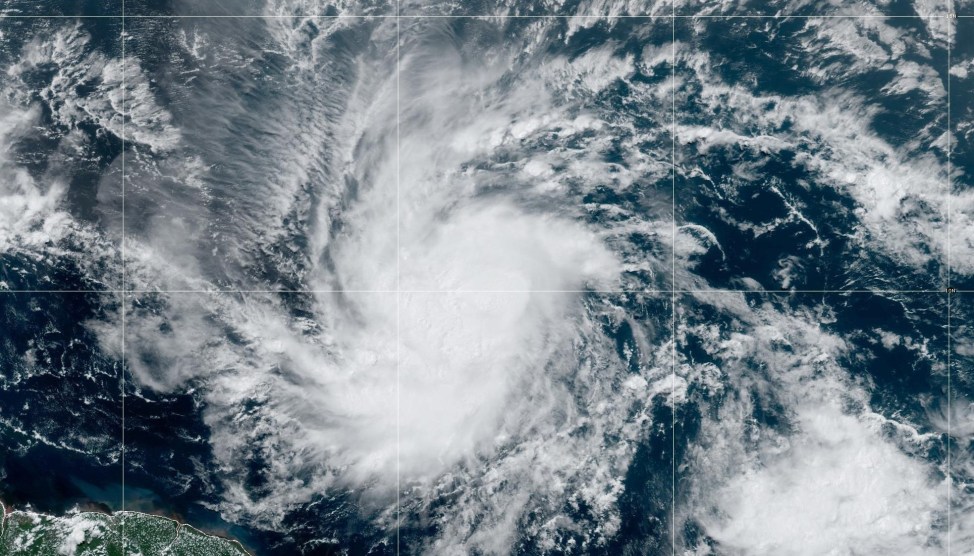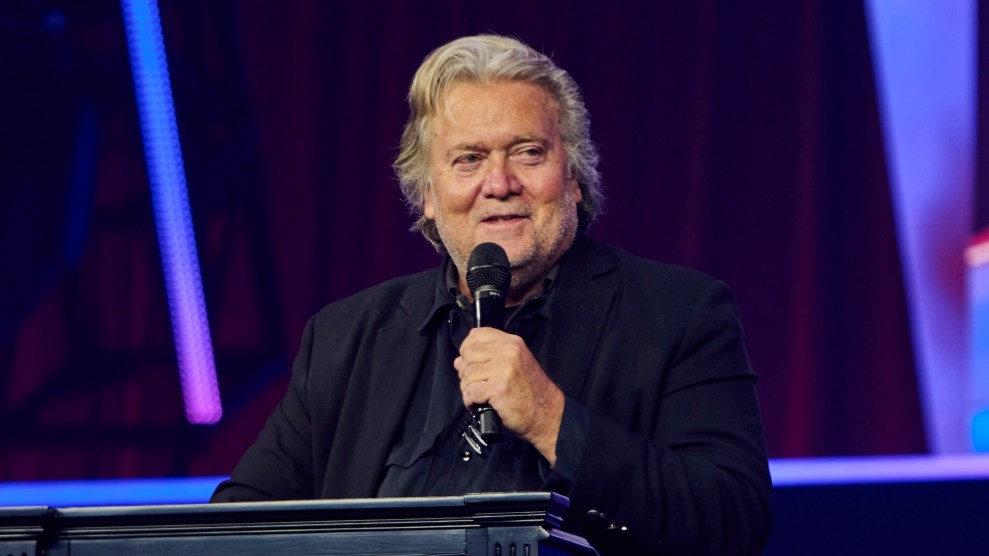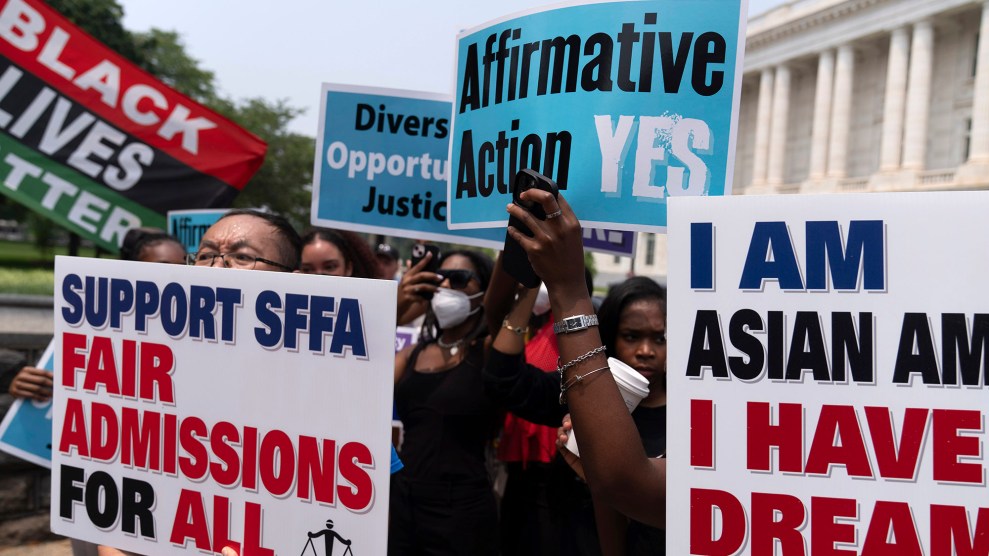Early this month Vice President Al Gore and a nonprofit climate group launched what they say will be a three-year, $300 million advertising campaign to convince the American public of the need for legislation to address climate change. The campaign, a project of the Gore’s Alliance for Climate Protection, uses slick national TV ads to encourage people to sign up as online activists. So far, three ads have aired and more than one million people have joined. Mother Jones recently spoke with Alliance spokesman Brian Hardwick.
Mother Jones: How do you think the campaign can make a difference?
Brian Hardwick: This campaign is unprecedented in scale among issue advocacy efforts. In the past, this issue hasn’t had the benefit of a commercial-scale campaign. The second thing is, we have available to us all the tools of mobilization that the online space also provides. So we can inspire people and connect with them emotionally though television advertisements but we also have a way to engage people in the movement that we previously didn’t have. When we get people to sign up [online], then we turn them into climate activists.
MJ: Who do you hope to reach?
BH: It’s really targeted at Americans from all walks of life. That’s why we’re doing the advertising in a mass way like this. We want to reach people who have been active already on the climate issue, and then those who maybe have changed a light bulb and are driving a hybrid car but don’t know what the next step is, and then people who are just becoming aware of the issue. It really is saying to all Americans that doing those things in your personal life are important, but frankly to really solve this it is going to take enough of us coming together and demanding from leaders and business and government that they put the laws in place to ignite a new economy. We need a real shift in public opinion and activism so that we can say to our leaders: we’re ready to solve it.
MJ: Elsewhere you’ve said you are trying to reach “influentials.”
BH: The thing about this influencer target, they’re not your typical opinion elite. These are people who talk to a lot of people every day, they are people who know what’s on the cutting edge of news, they know who got voted off American Idol last week, they are the types of people who know what the fashion trends are. We are really looking for ways to accelerate a big budget but frankly a budget that we wish was a whole lot bigger than that.
MJ: Is there a particular Madison Avenue campaign that you are modeling this on?
BH: Not a particular one, although there is a long list of social issues, from the anti-littering campaign to the “This is your brain on drugs” campaign to the Truth Anti-Smoking campaign to the crash test dummies on seat belts—there have been social issues that have had television-commercial scale, but we are combining that with all of the online tools. We are doing a ton of online advertising as well as print advertising. So we are kind of taking the best practices that we’ve learned from those social marketing exercises and the cutting edge methodologies that are out there for consumer marketing and kind of putting those together in this effort.
MJ: Who is involved from the ad world?
BH: Our agency is the Martin Agency out of Richmond, Virginia. They have been made famous recently by making the Geico ads that include the Geico gecko and the cave men ads. They also do the ads for UPS—”What can brown do for you?”—and the UPS white board. They are considered one of the hottest creative shops in the country right now and have some really memorable advertisements out there.
MJ: What kind of parallels do you see between their past work and what you want them to do?
BH: I think that they have a real sense of helping people connect with brands in the consumer world and they also have a really good sense of making commercials that are memorable and get talked about. I think the Geico ads are an example of that. These are ads that people talk about around the water cooler, and frankly, they didn’t have much to do with car insurance, except that they’re good at driving simple messages: it’s so easy a cave man can do it. And they are very good at direct response marketing. They say “Call 1-800, get a free quote, take three minutes.” Our whole thing is driving people to WeCanSolveIt.org, and so you’ll see that feature in all our advertising.
MJ: Your first ad featured scenes of major American conflicts and achievements—civil rights protests, an astronaut landing on the moon. Explain how you see the ad working.
BH: From the very beginning we wanted to both communicate the urgency of the climate crisis—that we need to act now, because that’s what the scientists tell us—but also that we can solve this, that the solutions are out there, we just need to get behind them. What we are evoking in this first spot is the sense that in these key moments in history, Americans didn’t wait. We didn’t wait four more months to go into Normandy; we went in when we had to. We went to the moon. We took on civil rights. When Americans come together in a big way they also get great things done. That’s the spirit that we’re tapping into, but the other thing we are saying is that we can solve the climate crisis. We are issuing an invitation saying, “Join us.” Everybody has heard a lot about the problem. We really want to get in there and start talking about solutions.
MJ: What other kinds of ads can we expect?
BH: The next set of ads will pair people who don’t agree on virtually anything but do agree that we need to act on the climate crisis. The point being: for too long environmental issues have been polarized or politicized. Really this is an issue that impacts all of us and we need to not look at it through a typical partisan lens, or a lens that says, “You’re on this side or you’re on that side.” This is an issue where we’ve got to put our differences aside and act quickly. So you’ll see Pat Robertson with Al Sharpton, Nancy Pelosi with Newt Gingrich, Toby Keith and Natalie Maines from the Dixie Chicks. You’ll see people who you don’t expect to see together saying, “We don’t agree on anything, but we do agree on this.” The point there is to really call on Americans to look at this issue differently than a lot of environmental issues.
MJ: How will the online component play out?
BH: The online component is the hub of our campaign. WeCanSolveIt.org is an easy way for people to get involved and stay involved in ways that make sense for them. We’re going to have activism from your own house all the way up to the White House.
MJ: How deeply do you plan to drill into the policy issues?
BH: We’re not a lobbying organization. We think the best niche we can fill is really starting to engage people in a way that will demonstrate to leaders that there is real demand out in the public for action, and we think that provides the fodder that other groups need to convince lawmakers that it’s time to act.
MJ: Are we going to see any cameos by Al Gore or “Inconvenient Truth” references?
BH: We are just going to roll out the ads as we get them done. We’re not going to project on what may or may not happen down the road.
MJ: Are you worried that you will be outspent by groups on the other side?
BH: We know they will be advocating for their position as well. Ultimately, we think our arguments are stronger. It will cost us more if we don’t act. You can’t let people tell you that it’s bad for the economy to begin to start trying to solve the climate crisis, because ultimately what we can build is a new economy, jobs of the 21st century that are driven by American innovation. We could actually lead the world in the same way that we did with the Internet and technology boom and frankly with the Industrial Revolution. This is a country that has constantly risen to the economic challenges of the future. There are people right now who are laid off from mills in Western Pennsylvania who are now working at factories making wind turbines. That is happening across America and we are going to tell those stories.














